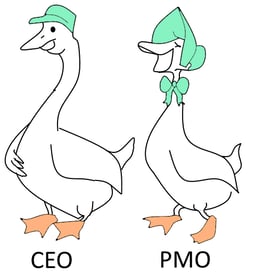McKinsey Research: 40% More Value from a Portfolio?
Updated:
Published:

Yes, you read that right; the Gods have spoken. According to McKinsey, it’s possible to get 40% more from a portfolio by engaging in one rather simple activity.
Active prioritization and portfolio management.
Now anyone who’s read my blog before will be used to me banging on about strategic planning and prioritizing your project portfolio, but McKinsey? I mean, they’re C-suite heavyweights!
But of course, there’s a twist.
Active prioritization improves performance
So strong prioritization and resource allocation is key to getting the most out of your portfolio of projects – great. But McKinsey wasn’t looking at the kinds of projects we normally talk about in this blog. They were looking at resource allocation across the whole company. This is strategic planning. It's kind of like project portfolio management amplified, with stakes way higher, and budgets way bigger than most of us ever dream of.
Most organizations take a “let’s just do what we did last year again…” approach to managing their corporate resource allocation. The portfolio really doesn’t change very much over time.
What McKinsey’s research has shown is that organizations that actively manage their resource allocation - their portfolio of businesses and the initiatives in which they engage - outperform their more static competitors by a massive 40%!
This is strategic planning.
Why might this be?
I haven’t had the pleasure of quizzing the folks who did the research, but we can guess why this might be.
First of all, an organization willing to ask questions and to take the risks associated with re-jigging their business is probably a more progressive and open organization in the first place.
Second, the process of prioritization means that you have to define and clarify your goals and priorities. The act of doing this means that you can not only make better decisions, but you can also communicate more clearly what’s important to the rest of the organization. This means that lower-level managers can start to align their decision-making with corporate strategy (gee! Where have I heard that before?)
With clear priorities, you can make clearer resource allocation decisions taking into account capacity (our software really helps here, with AI doing a lot of the hard "what-if" work for you). Not overloading resources means you get to deliver initiatives faster and with higher quality.
Finally, the act of asking these questions encourages everyone to spend just a little time thinking about what’s important. Reflecting on why you’re there, what you’re there to achieve, has a wonderful effect; it helps you focus on what’s important and stop doing things that are slowing you down.
Each of these points has a direct analogue in the project prioritization process. Organizations that actively align the project portfolio with strategy are probably just “higher performance” organizations in the first place. Being able to clearly articulate priorities helps pick projects from the existing pool of request, but it also helps departments / project sponsors come up with “better projects” to work with. And finally, the process of setting out corporate priorities and throwing back projects that aren’t aligned encourages managers to reflect on what they are doing and to focus on strategic alignment.
What Benefits the PMO, Benefits the CEO
In England, there’s a popular saying: "What’s good for the goose (female goose) is good for the gander (male goose)". It simply means, what’s good for one person is also good for someone else..
Now, you might be wondering what this has to do with McKinsey’s research. I’ve previously discussed how enhancing the project prioritization process can bolster your career as a member of a Project Management Office (PMO). Interestingly, this holds true for CEOs as well.
CEOs who actively steer their strategic portfolios are substantially less likely to lose their positions compared to those who don't. (As a side note, it's intriguing that McKinsey’s metric for success among these CEOs is rooted in job retention).
Essentially, what is advantageous for the PMO – namely, the active allocation of resources underpinned by value-driven prioritization – is equally beneficial for the CEO.
If this resonates with you, consider sharing these insights with your executive team. Their openness to revamping the prioritization process could be pivotal (Slide deck: Introducing Project Prioritization to your key stakeholders).
Given the importance of active prioritization and strategic alignment, it’s essential to gain practical knowledge on implementing these concepts within your organization. For deeper insights and a comprehensive overview, I urge you to explore our Strategic Alignment Guide. Therein, you’ll also discover a webinar that imparts in-depth understanding of how to effectively attain strategic alignment. This resource is indispensable for those aspiring to elevate the performance of their organizations.
